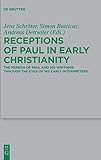Receptions of Paul in Early Christianity : The Person of Paul and His Writings Through the Eyes of His Early Interpreters / ed. by Jens Schröter, Simon Butticaz, Andreas Dettwiler.
Material type: TextSeries: Beihefte zur Zeitschrift für die neutestamentliche Wissenschaft ; 234Publisher: Berlin ; Boston : De Gruyter, [2018]Copyright date: ©2018Description: 1 online resource (X, 910 p.)Content type:
TextSeries: Beihefte zur Zeitschrift für die neutestamentliche Wissenschaft ; 234Publisher: Berlin ; Boston : De Gruyter, [2018]Copyright date: ©2018Description: 1 online resource (X, 910 p.)Content type: - 9783110533705
- 9783110533729
- 9783110533781
- online - DeGruyter
- Issued also in print.
| Item type | Current library | Call number | URL | Status | Notes | Barcode | |
|---|---|---|---|---|---|---|---|
 eBook
eBook
|
Biblioteca "Angelicum" Pont. Univ. S.Tommaso d'Aquino Nuvola online | online - DeGruyter (Browse shelf(Opens below)) | Online access | Not for loan (Accesso limitato) | Accesso per gli utenti autorizzati / Access for authorized users | (dgr)9783110533781 |
Browsing Biblioteca "Angelicum" Pont. Univ. S.Tommaso d'Aquino shelves, Shelving location: Nuvola online Close shelf browser (Hides shelf browser)

|

|

|

|

|

|

|
||
| online - DeGruyter Al-Kashshaf : Al-Zamakhshari's Mu'tazilite Exegesis of the Qur'an / | online - DeGruyter Returning to Tillich : Theology and Legacy in Transition / | online - DeGruyter Victims, Perpetrators, and the Role of Law in Maoist China : A Case-Study Approach / | online - DeGruyter Receptions of Paul in Early Christianity : The Person of Paul and His Writings Through the Eyes of His Early Interpreters / | online - DeGruyter Leibniz und Guericke im Diskurs : Die Exzerpte aus den Experimenta Nova und der Briefwechsel / | online - DeGruyter Der Erste Weltkrieg zur See / | online - DeGruyter Phonetik und Phonologie des Italienischen : Eine Einführung für Studierende der Romanistik / |
Frontmatter -- Table of Contents -- Preface -- I Prolegomena -- Introduction -- Paulus im ältesten Christentum -- II The Reception of the Pauline “Gospel” in EarlyChristianity -- Proclaimed Message or Proclamation of the Message? -- Lorsque Paul parle d’Evangile dans lapremière lettre aux Corinthiens -- III (Auto-)Biographical Receptions of Paul -- Das Selbstverständnis des Paulus als Apostel -- Biographie und Rhetorik -- Die Akten des Paulus und der Thekla als biographische Paulusrezeption -- The Conversion of Paul: A New Perspective (Epistula Apostolorum 31–33) -- IV Paul and his Work: Sociological and EconomicEffects -- Pauline Assemblies and Graeco-Roman Associations -- Zwischen Elend und Elite -- V Theological Receptions of Paul -- Der Kolosserbrief als ethischer Text –zugleich ein Beitrag zur Frühgeschichte derPaulusrezeption -- Paulus als Ökumeniker -- „Dies ist die geistige Auferstehung“ -- The Ecclesiology of 2 Clement 14 -- VI Literary (Epistolary and Narrative) Receptionsof Paul -- Paul et la mémoire lucanienne des Origines -- Der 2. Thessalonicherbrief im Verhältnis zum 1. Thessalonicherbrief -- Hébreux et la tradition paulinienne -- VII Pauline Reception as Pauline Tradition -- Paulustradition und Paulusrezeption in den Pastoralbriefen -- La tradition paulinienne dans les lettres d’Ignace -- VIII Paul as an Authoritative Figure in EarlyChristianity -- Paul, Clement and the Corinthians -- Apocalipsis Pauli/Visio Pauli – Warum eigentlich Paulus? -- Apostolic Authority and Women in Second-Century Christianity -- Pauline Reception in Valentinian and Basilidian Gnosis -- IX Anti-Paulinism and Conflicts about Paul in EarlyChristianity -- Kreuzfeuer -- Antipauliner oder Zeugen eines nichtpaulinischen Christentums? -- La construction de l’homme ennemi ou l’anti-paulinisme dans le corpus pseudo-clément -- X Constructing the “Canonical” Paul -- Ungetrennt und Unvermischt? -- Marcion and the Canonical Paul -- Sammlungen der Paulusbriefe und die Entstehung des neutestamentlichen Kanons -- XI Pauline Reception: Archeological and EpigraphicEvidence -- Epigraphic Evidence for the Impact of Paul in Central Asia Minor -- List of Contributors -- Index of Ancient Sources -- Index of Modern Authors
restricted access online access with authorization star
http://purl.org/coar/access_right/c_16ec
The volume deals with interpretations of Paul, his person and his letters, in various early Christian writings. Some of those, written in the name of Paul, became part of the New Testament, others are included among „Ancient Christian Apocrypha", still others belong to the collection called „The Apostolic Fathers". Impacts of Paul are also discernible in early collections of his letters which became an important part of the New Testament canon. This process, resulting in the „canonical Paul", is also considered in this collection.
Wirkungen von Person und Theologie des Paulus finden sich bereits in solchen Schriften, die noch ins Neue Testament gelangt sind. Aber auch Texte, die zu den antiken christlichen Apokryphen oder zu den "Apostolischen Vätern" gerechnet werden, berufen sich auf seine Autorität und führen Aspekte seiner Theologie weiter. Die darin erkennbar werdende Vielfalt von Anknüpfungen an Paulus deckt sich nur zum Teil mit der Theologie, die sich aus seinen Briefen erheben lässt. Daran wird deutlich, dass Paulus im frühen Christentum für verschiedene Fragestellungen in Anspruch genommen wurde: für Diskurse über Autoritätskonstellationen, Askese, Leiblichkeit und Auferstehung, aber auch für Diskussionen über das christliche Gottesbild. Nicht zuletzt sind soziologische Aspekte im Blick auf die von Paulus gegründeten Gemeinden zu beachten.Die Wirkungen des Paulus haben zur Sammlung seiner Briefe geführt, die zu einem wichtigen Bestandteil des Neuen Testaments geworden sind. Auch dieser Prozess, der zum „kanonischen Paulus“ geführt hat, wird in dem Band behandelt. Auf diese Weise entsteht ein facettenreiches Bild der von Mission und Theologie des Paulus ausgegangenen Wirkungen für die christliche Theologie und die Entstehung des Neuen Testaments.
Issued also in print.
Mode of access: Internet via World Wide Web.
In English.
Description based on online resource; title from PDF title page (publisher's Web site, viewed 28. Feb 2023)


